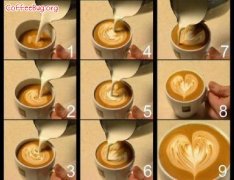Barista examination some summaries of the barista Qgrader examination
After successfully passing the Q GRADER exam, some friends who are interested in the Q GRADER exam have asked me about the exam. It is true that there is less data in this area. Therefore, I would like to make a general summary here to give some reference to friends who want to take the Q GRADER.

First, about the examination subjects
Q GRADER is an exam jointly certified by SCAA and CQI. At present, the examination will take five days, with a total of 22 subjects. If you pass all the subjects, you can get Q GRADER certification. If you have failed subjects, you can pass the make-up exam within 18 months. Specific subjects include:
① 1 Coffee General knowledge written test, answer 100 multiple choice questions within 1 hour, answer more than 75 correctly can pass.
② 3 taste threshold test refers to the identification of sour, sweet and salty taste. One of them is to find out which of the nine cups of water are sweet, sour and salty, and the other is to distinguish the three concentration levels in each of the three cups of sour, sweet and salty. One door is three flavors, three grades, that is, nine solutions, which are mixed with each other, and then there are eight cups of mixed solution. let you point out what flavors and concentration levels are in these 8 cups of solution (it may be a mixture of two flavors, or it may be a mixture of three flavors).
The ③ 4 door smell bottle smell test refers to the 36 flavor bottle of coffee nose. Among them, it is divided into 4 groups according to the cause of taste, so there are 4 separate tests. The way of the test is to take a lianliankan look at 9 bottles on one side and 6 bottles on the other side, asking you to point out which of the 6 bottles in the other group is the other group of 9 bottles. Then write down the specific taste of the specified 3 bottles. During the exam, the lights will be turned off, only the red light will be turned on, and the bottles will be wrapped in order to prevent candidates from judging by color.
④ 5-door triangular cup test is 5 rounds, each round 6 groups. There are 3 cups in each group, of which 2 cups are the same and 1 cup is different. Find out which cup is different. There can be at most one wrong group in each round of 6 groups. During the exam, the lights will be turned off, only the red light will be turned on, and candidates will not be allowed to observe the coffee powder through color.
⑤ 1 organic acid test, that is, there are 8 groups of coffee, each group of 4 cups, of which 2 cups are added with acid (citric acid, malic acid, phosphoric acid, acetic acid). Find these two cups. Then write down what kind of acid is added.
⑥ 1 sample baking identification, (through Agtron and students' sensory ability to observe coffee beans to test whether students understand the baking degree of SCAA standard samples) is based on the color of coffee beans and coffee powder to determine whether it conforms to the SCAA cup test standard for baking color.
The ⑦ 1 raw bean grading test is a 20-minute group with a total of three groups to select raw beans, pick out various defective beans specified by SCAA, and explain what kind of defects they are, calculate the number of defects, and judge whether they are fine coffee or non-boutique coffee according to the defects.
⑧ 1 cooked beans identification, according to the SCAA standard, in the cooked beans to select whether there are QUAKER beans, and indicate whether it is a high-quality coffee.
The ⑨ 5-door coffee cup test is based on the SCAA cup test for 5 rounds (Brazil, Colombia, East Africa, Indonesia, Central America). There are six sets of coffee in each round. Six kinds of coffee in each producing area were scored on the basis of SCAA cup meter. Check to see if your score matches the score of the coffee.
Second, about the preparation and feeling of the examination
① first let's talk about the fragrant bottle, which is a subject that I feel relatively well prepared in the process of preparing for all the examination subjects.
Coffee nose 36 flavor, is divided into four groups: enzymatic reaction, caramel reaction, distillation reaction and aroma pollution, each 9 bottles. When I practice, I find out each of the nine bottles, remember what they taste, and then smell them over and over again. The most important memory help is that when I practice, I compare the coffee flavor wheel of SCAA, memorize the structure of the flavor wheel and all the groups and flavors, and then memorize it and correspond to the smell of the four groups of incense bottles one by one. I fully understand the relationship between the flavor wheel and the coffee nose.
②, let's talk about the written test. This is a threshold set by the Q GRADER exam to see if the coffee knowledge accumulated by candidates is rich enough. It can be said that the examination questions cover a wide range of areas, including planting, varieties, producing areas, processing, cup testing, production, and even trade.
I suggest that you should read as many coffee books as possible on the basis of reading SCAA cup test manual and raw bean defect manual.
③ raw bean grading, in 20 minutes to pick out 350g samples in accordance with the SCAA requirements of all defects, and then to fill out the examination paper, time is still very tight.
Candidates are advised to familiarize themselves with SCAA's manual on raw bean defects, be proficient in 6 first-class defects and 10 second-class defects, and keep in mind the defect points of each one. Only in this way can we have enough time.
④ about the taste threshold test. Sweet, sour and salty solution with different concentrations mixed together and then to distinguish the taste, but also write down the grade, I think it is very difficult.
I focused on practicing this link before the exam. Stick to drinking those sour, sweet and salty water with three levels of concentration each, a total of 9 bottles of water, to mix them up for practice. I thought I had 9 bottles of water and practiced by myself every day, which was serious. Unexpectedly, I met a classmate in this exam. It is said that he had more than 60 bottles of water, that is, he practiced with a bottle of all possible flavors and concentration levels. It was so powerful.
⑤ triangle cup test. This has a lot to do with one's sense of smell and taste. Five rounds of examination questions are also getting more and more difficult. In the first round, group 6 can roughly determine which cup it is by smelling the coffee powder, and then reconfirm it when drinking it. In the last round, almost six groups of coffee, none of them could accurately tell by smelling the dry powder, and even the taste was the same when drinking it. I personally distinguished it by the different locations of the tongue irritation after the coffee was inhaled into the mouth, because it's really hard to tell the flavor.
⑥ organic acid, baking sample identification and cooked bean identification are basically easy subjects in the exam. Most of them should pass. Organic acids can basically pass as long as they are sensitive to acidity and can tell which cup is added with acid. Baking sample identification, mainly to understand the SCAA for cup measurement of coffee roasting degree regulations, for 58, 63 those chromatographic values to understand what the meaning of the basic can be passed. The identification of cooked beans is to look for QUAKER beans in 100g cooked bean samples.
⑦ about the cup test of the five, need to rely on coffee experience. There are 5 rounds of coffee, each round of 6 groups of coffee, scored according to the SCAA standard, the score should be close to the standard score of the coffee. And in each round, the good or bad trend of 6 groups of coffee should be correct, some of the 6 groups of coffee are good and some bad, and the fine products should be clearly distinguished from the non-fine ones.
In each round of the exam, the lecturer will first take out a cup of coffee for grading and correction, itemized to count everyone's score and the lecturer's score. Determine the score for this calibrated cup of coffee. This part is also the place where I feel the greatest gain in this exam. In the formal examination, the corrected coffee will also be one of the six groups of coffee, but the examinee will not tell which group it is to see if the coffee can be graded again to see if the corrected standard can be met.
I hope these will be helpful to the next friends who are going to take the Q GRADER exam.
Important Notice :
前街咖啡 FrontStreet Coffee has moved to new addredd:
FrontStreet Coffee Address: 315,Donghua East Road,GuangZhou
Tel:020 38364473
- Prev

Make your own coffee three practical ways to make coffee
If going to a coffee shop is a kind of leisure and drinking coffee is a kind of cognition, then drinking coffee every day is a kind of just need, so as to form the so-called food culture. So our opinion is: drink your coffee first. Regardless of the environment, regardless of the flavor, the key is: today, do you drink coffee? When you get used to coffee, you fall in love with the feeling of scratching your stomach. When all kinds of sweet
- Next

Espresso Coffee drawing course Love heart drawing steps
1. Inject the milk foam from the center of the coffee with a little effort. 2. Make full use of the impulse of milk to make coffee and milk blend. 3. When you continue to merge until eight minutes are full, shake the cup close to the surface of the coffee and around the edge of the cup. 4. While continuing to shake, it has just been moved forward slowly. 5. At the center point, pull up the steel cup. 6. Keep the steel cup high
Related
- What is the meaning of lactic acid fermentation with coffee bean treatment?
- How to judge the state of foam by sound?
- How does the latte pull out the unicorn pattern? Come to get for a little trick to improve the flower pull!
- Will flower pulling affect the taste of the latte?
- Do you know the history of coffee?
- The difference between honey treatment and sun washing what is raisin honey treatment?
- What kind of milk can a novice use to make coffee foam to keep the foam longer? The correct method and skills of milking tutorial sharing
- Why do washed coffee beans taste sour? Flavor characteristics of washed Coffee
- Introduction to the skill of how to practice the size and height of water injection around the circle of hand-brewed coffee
- How do beginners practice coffee flower drawing from scratch?

